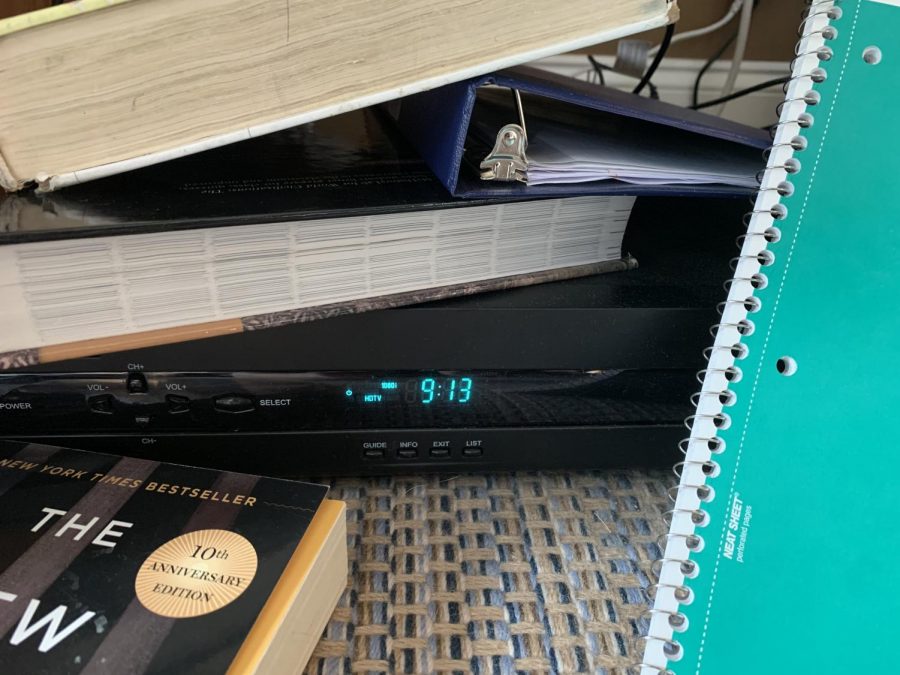Learning to Learn Remotely During the Coronavirus Pandemic
Schoolwork surrounds a digital clock, as the virtual school day begins.
On March 23rd, 2020, the novel Coronavirus pandemic forced Bronx Science to make a massive shift to remote learning with little over a week to prepare. This fall, things are different — with over three months to prepare, the Bronx Science faculty have created the closest thing possible to an in-person experience over the internet through Zoom and Google Meet virtual classes. However, with dozens of assignments suddenly appearing each week on Google Classroom as well as several hours each day of live video classes, it has been an adjustment for Bronx Science students.
The first issue apparent for many students is the loss of a designated lunch period in favor of a mix of short times in between classes and occasional free periods on account of the NYC DOE mandates that each virtual class be capped at 120 minutes of live video per week (as the year goes on, this number will slowly increase). Bhaskar Chakrabati ’22 said, “Normally, my schedule was very predictable. Now, I sometimes don’t have time to eat lunch until 2 o’clock, and I have random breaks on some days of the week.” On days when a student’s free periods and lunch do not align, no perfect solution exists. One recommendation would be to just reheat a full lunch or quickly get a snack between classes and then eat during the following period.
For many in the Bronx Science community, another problem lies in what happens after the school day is over. The average workload has gone up dramatically from last Spring as teachers have adjusted to their new ‘virtual class’ reality, and coupled with the fact that learning over the internet is still new to everyone, dealing with Zoom fatigue, homework, and assessments has been an adjustment for faculty and students alike.
There are only so many hours in the day, so efficiently using your time will be the key to success this year. It is undeniable that faculty will need to adjust their expectations as well. Teachers on behalf of the Assistant Principals in each academic department have sent out surveys to students in order to get an idea of how much work is reasonable, which is a welcome development. However, even beyond adjusting students’ workloads, teachers need to remain more aware than ever of students’ mental health during this difficult time of the global Coronavirus pandemic.
Thankfully, there are a number of ways that students have already begun to adapt, which can be used by everyone to get an edge. The first great way is to stay on top of one’s work by creating a personal schedule instead of leaving it to websites like Google Classroom and Pupilpath. Leona Teten ’23 said, “the most helpful thing to me has been actually using a planner to keep a to-do list. It really helps me stay on top of my asynchronous work.”
To take full advantage of a calendar or a similar tool, though, a crucial step is making sure to consciously avoid procrastination. With a high influx of work and Google Classroom’s tendency to only show work due in the next week on the first view screen, it is easy for homework and assessment deadlines, in particular, to slip by until the last moment. A helpful strategy is to use this year’s schedule changes to your advantage. Derrick Tan ’21 said, “I keep alarm clocks for the beginning of each synchronous class and use my asynchronous time/free periods to do my homework and get it done right off the bat,” This advice could help you to shave hours off of the free time allocated to everything from new to overdue assignments.
One time management strategy, the ‘Pomodoro technique’, has been gaining traction. Essentially, the technique involves setting a timer for a high-focus work session of typically 25 minutes, taking a 5-minute break, and repeating, with longer breaks each time. Victoria Diaz ’22 started using the Pomodoro method to maintain productivity. She said, “I often have Zoom meetings with my friends so that we can work on homework collaboratively.”
The power of applications like Zoom to make things like studying easier does not start and end with friends’ schedules, though. Phoebe Marbid ’21 said, “I joined a study Discord six months ago that allows users to go to different study sessions. There are sessions for Pomodoro method: “silent” studying with lo-fi, screen share, camera on, and rooms just for small groups and duos. There are times when I can’t reach out to my classmates to study late at night, so this server has helped me a lot during those times,” she added.
Remote learning is a new challenge for the student body and faculty of Bronx Science alike, and handling the influx of work comes down to figuring out the best ways to study and to manage one’s time. Students have already made breakthroughs in figuring out how to make the best of this situation. As the year progresses and new methods increase in popularity and practicality, the learning process will only become easier.
“I keep alarm clocks for the beginning of each synchronous class and use my asynchronous time/free periods to do my homework and get it done right off the bat,” said Derrick Tan ’21.
Declan Hilfers is an Editor-in-Chief and Staff Reporter for ‘The Science Survey.’ He is attracted to journalism because it presents an outlet to bring...

